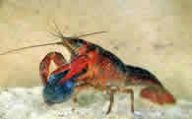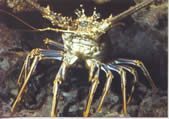Chemosensory Neurobiology & Behavior
Species studied:


- Crustaceans (lobsters, crabs, crayfish)
- Mollusks/Gastropods (sea hares)
- Cephalopods (squid, octopus, cuttlefish)
- Fish (flounder, bluehead wrasse, sea catfish)
Experimental approaches:
- Molecular and Biochemical: Identifying bioactive molecules
- Cellular: Calcium Imaging and Electrophysiology
- Systems: Coding of stimuli by chemosensory systems
- Behavior
Summary
The focus of research in the Derby lab involves studies of the chemical senses. Our general objective is to understand how nervous systems are organized to allow animals to detect, identify, and respond to natural chemicals. To explore these issues, we are using crustaceans (lobsters, crabs, crayfish) and other aquatic animals as model organisms, and a variety of techniques (molecular, immunocytochemical, anatomical, electrophysiological, and behavioral approaches).
Research Projects Include the Following
How do crustaceans communicate through pheromones?
We are examining chemical communication in crustaceans. Blue crabs communicate reproductive status via pheromones. For example, when female crabs are ready to mate, they release signals in their urine that elicit courtship display behaviors and chemical signaling by males. We are searching for the bioactive molecules constituting the sex pheromones of females and males. Another example that we are studying is social odors in spiny lobsters. Spiny lobsters are social animals that are socially attracted to each other via aggregation cues and that avoid damaged neighbors due to alarm cues in their blood. We are exploring the sensory biology of these behaviors, including identifying the signal molecules, receptor proteins, and sensory cells involved. We are also using electrophysiology and calcium imaging to understand how the nervous system encodes these stimuli.
Evolution of chemoreceptors: Receptor molecules of decapod crustaceans
Crustaceans use a diversity of receptor molecules as chemoreceptors. We are using bioinformatics (including single cell transcriptomes), molecular biology (immunocytochemistry, in situ hybridization), and imaging (confocal microscopy) to identify the chemoreceptor proteins (especially variant Ionotropic Receptors and TRP channels) of select decapod crustaceans, to understand how the molecules are organized within the nervous system to enable chemosensory behaviors, and to study their evolution.
Adult neurogenesis and the stem cell niche: How does the olfactory system stay functional in long-lived animals?
The olfactory organ of crustaceans is continually growing throughout the animal’s life. There is continuous turnover of olfactory receptor neurons in the antennule, with cell birth, maturation, and death occurring in less than one year. There is also continuous addition of new olfactory interneurons in the brain of adult crustaceans, and this neurogenesis occurs in a stem cell niche. We are examining the dynamics to these processes, using cell and molecular techniques, calcium imagining of odor responses, and other techniques.
Translational Chemoreception: Development of Synthetic Food Attractants in Aquaculture and Fisheries
In our work on sensory processing of complex stimuli, we have identified the compounds in food that are attractive to predatory crustaceans such as lobsters and crabs. We are using that knowledge to develop synthetic attractant mixtures that can be used in developing more sustainable feeds and baits in aquaculture and fisheries of crustaceans. Specifically, we are developing attractants to be incorporated into feeds for shrimp aquaculture and baits for crab and lobster fisheries. This translational research has led to collaborations with fisheries and aquaculture scientists and companies.
How do animals chemically defend themselves against predators?
A diversity of marine molluscs, including sea hares (Aplysia spp.) and cephalopods (squid, octopus, cuttlefish) chemically defend themselves against predators such as crustaceans, anemones, and fish by releasing an ink. This ink has many chemicals that act through diverse and interesting mechanisms. We are exploring these and other mechanisms of the sea hare’s chemical defense, and how these defensive molecules may be used for human applications, using a diversity of experimental approaches.